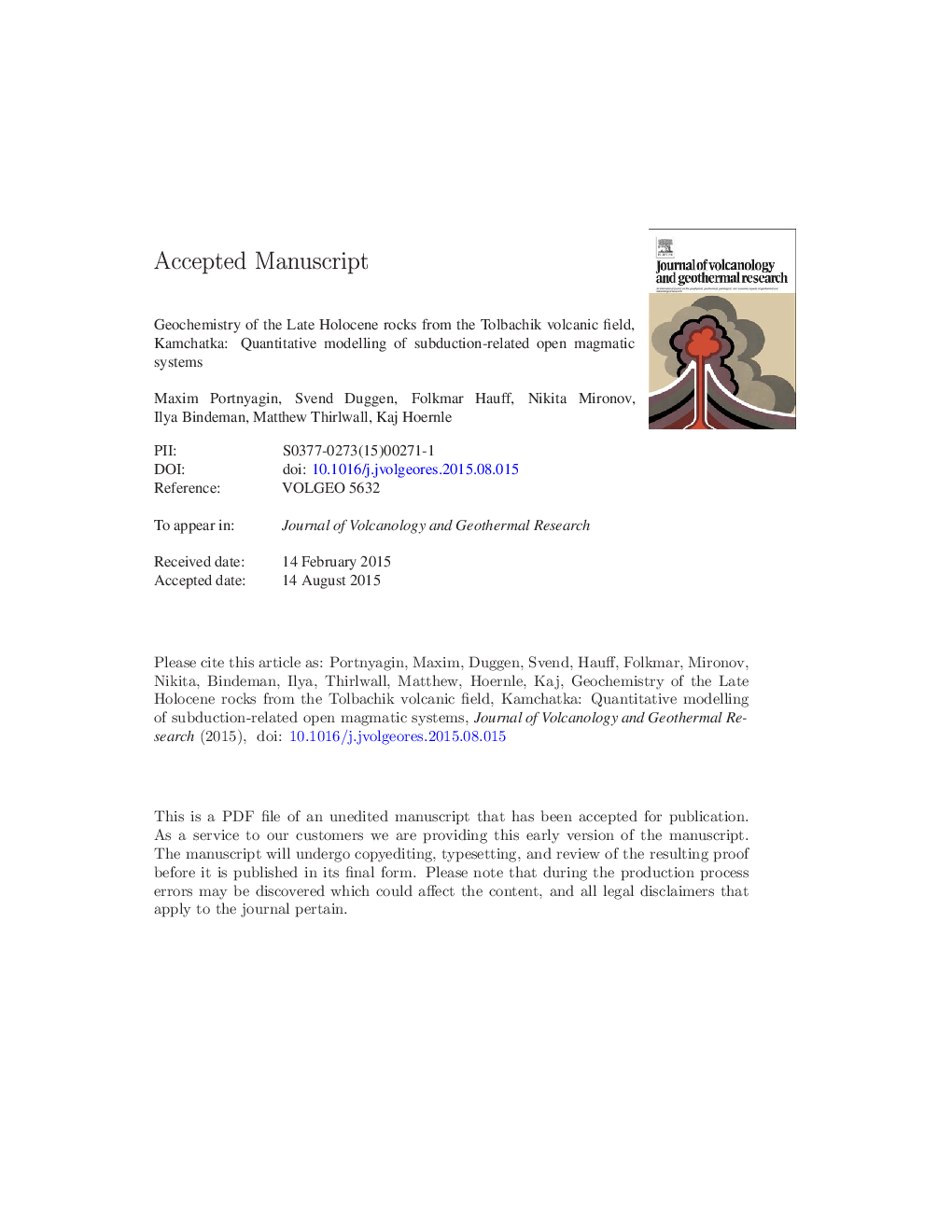| کد مقاله | کد نشریه | سال انتشار | مقاله انگلیسی | نسخه تمام متن |
|---|---|---|---|---|
| 6439634 | 1638315 | 2015 | 94 صفحه PDF | دانلود رایگان |
عنوان انگلیسی مقاله ISI
Geochemistry of the late Holocene rocks from the Tolbachik volcanic field, Kamchatka: Quantitative modelling of subduction-related open magmatic systems
دانلود مقاله + سفارش ترجمه
دانلود مقاله ISI انگلیسی
رایگان برای ایرانیان
کلمات کلیدی
موضوعات مرتبط
مهندسی و علوم پایه
علوم زمین و سیارات
ژئوشیمی و پترولوژی
پیش نمایش صفحه اول مقاله

چکیده انگلیسی
We present new major and trace element, high-precision Sr-Nd-Pb (double spike), and O-isotope data for the whole range of rocks from the Holocene Tolbachik volcanic field in the Central Kamchatka Depression (CKD). The Tolbachik rocks range from high-Mg basalts to low-Mg basaltic trachyandesites. The rocks considered in this paper represent mostly Late Holocene eruptions (using tephrochronological dating), including historic ones in 1941, 1975-1976 and 2012-2013. Major compositional features of the Tolbachik volcanic rocks include the prolonged predominance of one erupted magma type, close association of middle-K primitive and high-K evolved rocks, large variations in incompatible element abundances and ratios but narrow range in isotopic composition. We quantify the conditions of the Tolbachik magma origin and evolution and revise previously proposed models. We conclude that all Tolbachik rocks are genetically related by crystal fractionation of medium-K primary magmas with only a small range in trace element and isotope composition. The primary Tolbachik magmas contain ~ 14 wt.% of MgO and ~ 4% wt.% of H2O and originated by partial melting (~ 6%) of moderately depleted mantle peridotite with Indian-MORB-type isotopic composition at temperature of ~ 1250 °C and pressure of ~ 2 GPa. The melting of the mantle wedge was triggered by slab-derived hydrous melts formed at ~ 2.8 GPa and ~ 725 °C from a mixture of sediments and MORB- and Meiji-type altered oceanic crust. The primary magmas experienced a complex open-system evolution termed Recharge-Evacuation-Fractional Crystallization (REFC). First the original primary magmas underwent open-system crystal fractionation combined with periodic recharge of the magma chamber with more primitive magma, followed by mixing of both magma types, further fractionation and finally eruption. Evolved high-K basalts, which predominate in the Tolbachik field, and basaltic trachyandesites erupted in 2012-2013 approach steady-state REFC liquid compositions at different eruption or replenishment rates. Intermediate rocks, including high-K, high-Mg basalts, are formed by mixing of the evolved and primitive magmas. Evolution of Tolbachik magmas is associated with large fractionation between incompatible trace elements (e.g., Rb/Ba, La/Nb, Ba/Th) and is strongly controlled by the relative difference in partitioning between crystal and liquid phases. The Tolbachik volcanic field shows that open-system scenarios provide more plausible and precise descriptions of long-lived arc magmatic systems than simpler, but often geologically unrealistic, closed-system models.
ناشر
Database: Elsevier - ScienceDirect (ساینس دایرکت)
Journal: Journal of Volcanology and Geothermal Research - Volume 307, 1 December 2015, Pages 133-155
Journal: Journal of Volcanology and Geothermal Research - Volume 307, 1 December 2015, Pages 133-155
نویسندگان
Maxim Portnyagin, Svend Duggen, Folkmar Hauff, Nikita Mironov, Ilya Bindeman, Matthew Thirlwall, Kaj Hoernle,